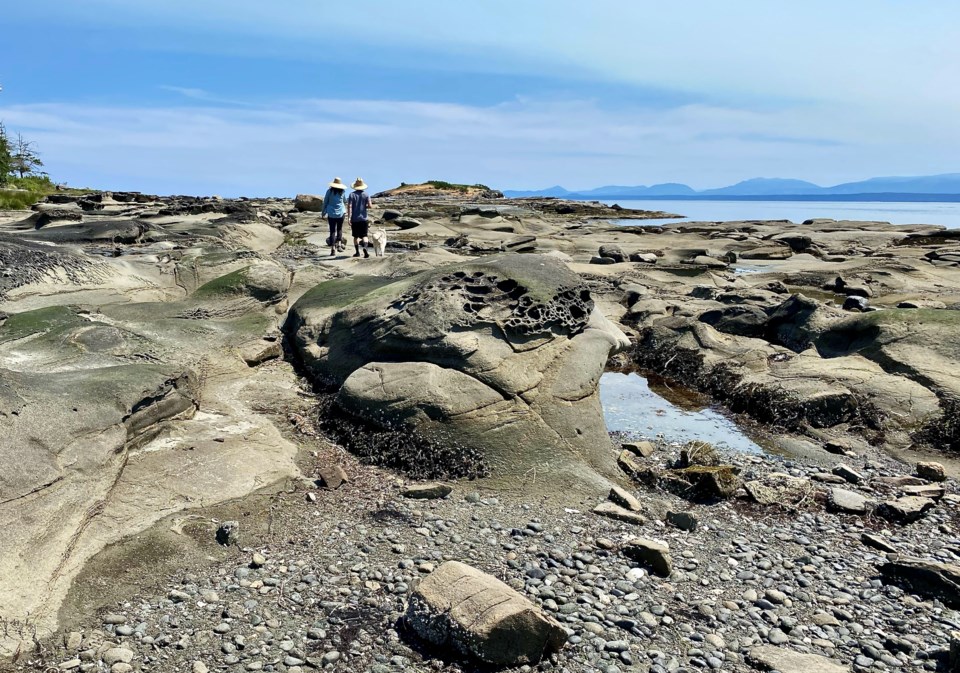During last week’s fine weather, my partner and I had a short but long-awaited vacation to Hornby Island. One of the lesser-known Gulf Islands, it’s a place of beauty, culture and character. It also has a third of its land preserved in parks and most of its shoreline open to the public—including a half-dozen excellent beaches. The large sand parabola at Tribune Bay Provincial Park is one of B.C.’s best.
But the beaches I liked were the ones ringed in rocks. Coupled with the erosion of rainfall and Pacific breakers, the Cretaceous sandstone and conglomerate underlying the island make for phantasmagorical formations. When you’re used to the grey, glaciated granodiorite of the Coast Range, such sedimentary sculpture immediately softens the maritime mood.
We hiked a different shoreline every day, highlights being Helliwell Provincial Park’s five-kilometre loop above spectacular bluffs through Garry Oak meadows and old-growth, the low-tide sandstone scramble out of Ford’s Cove, and the extensive trail network in Mount Geoffrey Park that gets you to the island’s 300-metre high point.
But I’m digressing. Although we had an amazing time, I couldn’t help but think about my other two forays to Hornby, a decade apart and the last time 28 years ago.
The first instance, in 1986, I’d still been tripping through the heady, free-wheeling existence of an extended adolescence. A Vancouver buddy and I took his Volkswagen van to Hornby to hang on the island’s nude beaches. Sometime during the dual ferry-crossing from Vancouver Island we acquired a German Rajneesh companion (remember the orange people and the Bhagwan’s 25 Rolls Royces?) who’d oddly named herself Amritsar, after the sacred Sikh city in India where British and Gurkha troops massacred 380 unarmed festival-goers in 1919.
The three of us spent a week living a feral carrot-juice and alfalfa-sprout dream of days spent wandering beaches in the buff, gazing into tidepools, and taking naps in the sun. Nights found us curled like vagabonds beside humongous logging-industry flotsam around a campfire, sleeping in the sand like cavemen until the brightness of the sun shocked us into consciousness. Amritsar did her best to instruct us in crystal-gazing and tea-leaf reading, and we filled her in on stuff we knew about—which was basically frisbee and hockey. It was a weird trip.
A decade later, while working at the Surfer Publications offices in California, I followed a ski assignment (another oddball story, but we’ll leave that for now) to Pemberton where, for reasons that remain unclear, a bike demonstration was going on in a field in the rain.
Call me naive, but until I actually saw it live, I had only the vaguest idea that an entire subculture of mountain biking existed in which people balanced in wheelies atop sawed-off logs, bunny-hopped sideways over the necks of petrified human volunteers lying in the grass, and pogoed their cycles up and down mounds of tottering rubble, eventually dropping metres to the ground off the roof of battered automobiles in a manner that more readily conjured a monster truck meet than anything athletic.
These feats of balance, strength, and impressive marginalia known as Trials Biking fascinated me, as did the rag-tag crew performing them, who apparently hailed from a bike-centric culture on a far-flung piece of land off the coast. And that’s how, later that summer, on assignment for the nascent BIKE magazine, I again travelled north from California to attend the Seventh Annual Hornby Island Bike Fest, an event dedicated to the entire depth and breadth of the mountain biking experience.
On Hornby, it seemed, mountain biking was king. A network of trails cut and maintained by residents held the island together like a well-woven salmon net: you could cross from one shore to another from anywhere using singletrack and bits of old logging road. The nexus for all of this was a 150-acre farm in the Strachan Valley owned by the Cross family since 1969, and site of Bike Fest.
Bike Fest drew dedicated riders in trials, dual slalom, cross-country, and downhill, as well as two-, three-, and four-way crossovers. Some were serious, some not much, and some not at all. There were men, women, children, pets, dirtbags, debutants, jerks, jocks, Vancouver Finance District weekend warriors, and full-time pro leisure tourers, partygoers, teetotalers, Jesus freaks, NORML crusaders, rednecks, and make-up-heavy bike groupies from Courtenay.
The other events were fun, but for me it was all about the alien proceedings of the B.C. Trials Championships. Held on a rocky bench near Tribune Bay, the short trials courses—collections of incredibly technical manoeuvres compressed into a few short yards of lunarscape rocks—drew a huge crowd. Many perched atop mushroom-like formations to watch, possibly advertising their mien. It was wild stuff, with enough dabs, ditches, and serious biffs to explain the shinpads and other protection (unknown at the time). It was impressive—but still weird, and afterward I crept away through the bush to the beach where I’d camped with Amritsar to ponder the worth of a nose-wheelie.
When I disembarked on Hornby this summer I noticed that little had changed: water as clear as a Caribbean reef and mountain backdrop as improbable as a 3-D postcard. The island’s hub, the Co-op Market and its adjacent ring of Hobbit kiosks, was also exactly as I remember: tie-dye, handmade jewelry, tarot reading, and eclectic hair and body adornment. And jammed between a fence and food concessions was the same bike shop as all those years ago, the rack out front crowded with mechanical steeds in the manner of a hitching post outside an old western saloon—where your ride is still king.
Leslie Anthony is a Whistler-based author, editor, biologist and bon vivant who has never met a mountain he didn’t like.




